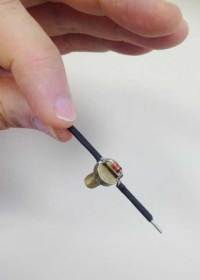TWIRP – dolphins-inspired radar can detect hidden surveillance and explosive devices
 Collaboration between researchers at the University of Southampton, researchers at the University College London, and Cobham Technical Services resulted in development of a novel kind of radar system called the twin inverted pulse radar (TWIRP) that can detect hidden surveillance equipment and explosives. Inspiration for the device scientists found in the way dolphin hunts the prey.
Collaboration between researchers at the University of Southampton, researchers at the University College London, and Cobham Technical Services resulted in development of a novel kind of radar system called the twin inverted pulse radar (TWIRP) that can detect hidden surveillance equipment and explosives. Inspiration for the device scientists found in the way dolphin hunts the prey.
TWIRP can distinguish real targets, such as certain types of electronic circuits that may be used in explosive or espionage devices, from other metallic items like pipes, beverage cans, or even nails that are commonly mistaken for genuine targets by traditional radar and metal detectors.
New radar system is based on unique sonar concept called twin inverted pulse sonar (TWIPS) developed by Tim Leighton, professor at the University of Southampton Institute of Sound and Vibration Research (ISVR). TWIPS is modeled on the natural abilities of dolphins to process their sonar signals to distinguish between targets and clutter in bubbly water. When hunting prey, dolphins have been observed to blow ‘bubble nets’ around schools of fish, which force the fish to cluster together, making them an easy catch for the dolphins.
TWIPS uses a signal consisting of two identical pulses with phase inverted in quick succession. According to the researchers, the technique could enhance linear scatter from the target, while simultaneously suppressing nonlinear scattering from oceanic bubbles. Leighton’s research team proposed that the TWIPS method could be applied to electromagnetic waves and that the same technique would work with radar.
In order to test the proposal, researchers applied TWIRP radar pulses to a representative target of interest (a dipole with a diode across its feedpoint – typical of circuitry in devices associated with covert communications, espionage or explosives) to distinguish it from ‘clutter’ (represented by an aluminum plate and a rusty bench clamp). The representative target of interest showed up 100,000 times clearer than the clutter signal from an aluminum plate measuring 34 by 40 cm (13.38 by 15.75 inches).
“As with TWIPS, the TWIPR method distinguishes linear scatterers from nonlinear ones. However, in scenarios for which TWIPS was designed, the clutter scatters nonlinearly and the target linearly – while in situations using TWIPR, these properties are reversed. For instance, certain electronic components can scatter radar signals nonlinearly if driven by a sufficiently strong radar signal, in contrast to naturally occurring objects which tend to scatter linearly”, said Leighton.
According to the researchers at University of Southampton, the diode target is light and small, inexpensive, very simple to manufacture and requires no batteries. Taking into account these features, and the fact that they can easily be tuned to scatter specific resonances to provide a unique identifier to a broadband TWIPR pulse, they offer the possibility of tags for animals or vehicles hidden in foliage, underground or in infrastructure (pipelines, conduits, etc.); and for humans entering hazardous areas, particularly where they might be underground or buried.
People who work in rescue teams, miners and climbers in avalanche areas can also carry the diode target. However, people without such tags might still be located by TWIRP, as it can be used to trace the bandwidth of mobile phone resonances, offering the possibility to locate victims by their mobile phones, even when the phones are turned off or the batteries have no charge remaining.
“In addition to the applications discussed above, such technology could be extended to other radiations, such as magnetic resonance imaging (MRI) and light detection and ranging (LIDAR), which, for example, scatters nonlinearly from combustion products, offering the possibility of early fire detection systems”, said Leighton.
For more information, you can read the paper published in the journal Proceedings of the Royal Society A: “Radar clutter suppression and target discrimination using twin inverted pulses” [1.1MB PDF].










Leave your response!